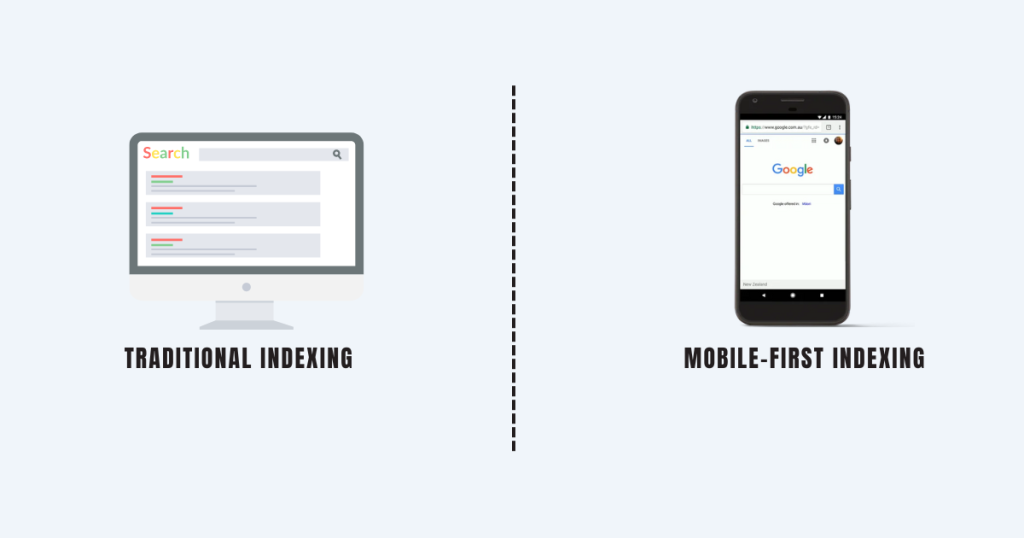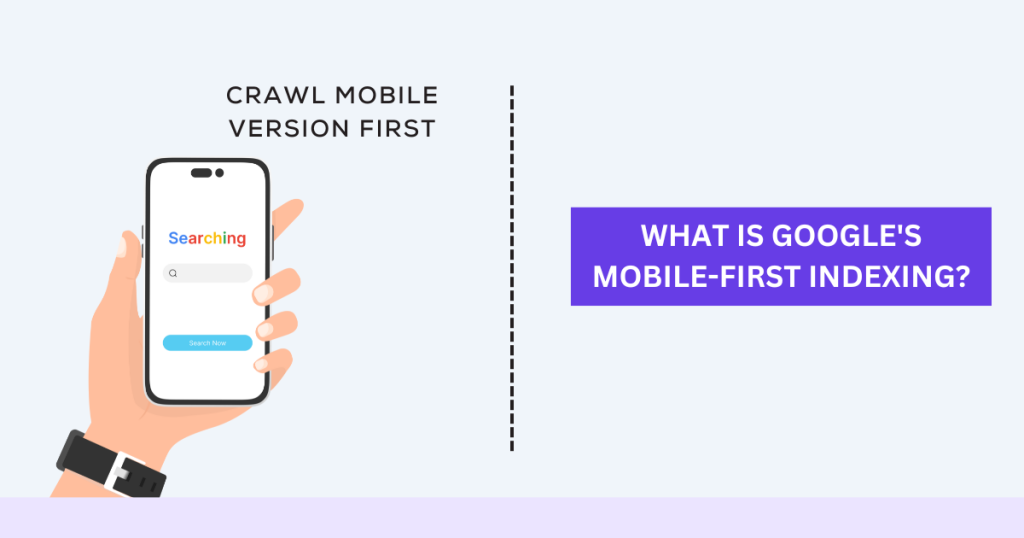In the world of digital marketing and search engine optimization (SEO), staying updated with the latest trends and changes is crucial. One of the significant changes introduced by Google is mobile-first indexing. But what is Google’s Mobile-First Indexing, and why is it so important for your website? In this comprehensive blog post, we will explore everything you need to know about Google’s mobile-first indexing, how it works, its benefits, best practices, and much more. By the end of this post, you will have a clear understanding of mobile-first indexing and how to optimize your website for it.
What is Google’s Mobile-First Indexing?
Mobile-first indexing means Google mostly uses the mobile version of your content to organize and decide how high it appears in search results. In the past, the indexing and ranking process was based on the desktop version of a website’s content. However, with the growing number of mobile users, Google decided to switch to mobile-first indexing to better serve the majority of its users who are accessing the web via mobile devices.
Why Did Google Introduce Mobile-First Indexing?
The introduction of mobile-first indexing is a response to the increasing use of mobile devices to access the internet. Here are some key reasons why Google made this shift:
- Increase in Mobile Usage: A significant portion of internet users now access the web through mobile devices. Google aims to provide the best possible user experience by prioritizing the mobile version of websites.
- Improved User Experience: Mobile-first indexing ensures that users get a better experience on their mobile devices by delivering content that is optimized for smaller screens.
- Accurate Ranking: By indexing the mobile version first, Google can accurately rank websites based on the content that users are most likely to see.
How Does Mobile-First Indexing Work?
Mobile-first indexing works by crawling and indexing the mobile version of a website’s content first. Here is a step-by-step overview of how the process works:
- Crawling: Google’s crawlers, also known as Googlebots, visit websites and analyze the content. With mobile-first indexing, Googlebots primarily crawl the mobile version of the site.
- Indexing: Once the content is crawled, it is indexed in Google’s database. The mobile version is used for this purpose.
- Ranking: Based on the indexed content, Google determines the relevance and quality of the website and ranks it accordingly in search results.
Differences Between Mobile-First Indexing and Traditional Indexing

| Feature | Traditional Indexing | Mobile-First Indexing |
|---|---|---|
| Primary Content Source | Desktop Version | Mobile Version |
| User Experience Focus | Desktop Users | Mobile Users |
| Ranking Based On | Desktop Content | Mobile Content |
| Adaptation Requirement | Desktop Site Optimization | Mobile Site Optimization |
Benefits of Mobile-First Indexing
Mobile-first indexing offers several benefits for both users and website owners:
1. Enhanced User Experience
Mobile-first indexing ensures that users get a seamless experience on their mobile devices. Websites optimized for mobile devices are easier to navigate and read, which leads to higher user satisfaction.
2. Improved SEO Performance
3. Increased Mobile Traffic
With more users accessing the web via mobile devices, having a mobile-friendly website can lead to an increase in mobile traffic. Mobile-first indexing helps capture this growing audience.
4. Competitive Advantage
Websites that adapt to mobile-first indexing have a competitive advantage over those that do not. By providing a better user experience, these websites are more likely to attract and retain visitors.
Optimizing Your Website for Mobile-First Indexing
Optimizing your website for mobile-first indexing is crucial to ensure that it performs well in search results. Here are some best practices to follow:
1. Responsive Design
Ensure that your website has a responsive design, meaning it adjusts seamlessly to different screen sizes and devices. This makes sure everyone sees your website the same way, no matter what device they’re using.
2. Mobile-Friendly Content
Make sure that your content is mobile-friendly. This includes using larger fonts, shorter paragraphs, and easily tappable buttons. Avoid using pop-ups that can be difficult to close on mobile devices.
3. Fast Loading Speed
Mobile users expect websites to load quickly. Enhance your website’s loading speed by compressing images, minifying CSS and JavaScript files, and utilizing browser caching.
4. Consistent Content
Make sure the content on your mobile site matches the desktop version, including text, images, videos, and other media. Any discrepancies can affect your rankings.
5. Mobile-First Design
When designing or redesigning your website, prioritize mobile-first design. This approach ensures that the mobile version is given priority in terms of layout and functionality.
Tools to Help with Mobile Optimization
There are several tools available that can help you optimize your website for mobile-first indexing:
1. Google Mobile-Friendly Test
The Google Mobile-Friendly Test tool allows you to check if your website is mobile-friendly. Simply enter your URL, and the tool will analyze your site and provide recommendations for improvement.
2. Google Search Console
Google Search Console provides insights into how Google perceives your website. It offers mobile usability reports that highlight any issues with your mobile site and provides recommendations for fixes.
3. PageSpeed Insights
Google’s PageSpeed Insights tool analyzes your website’s loading speed and provides suggestions for improving performance. This tool is essential for optimizing your site’s loading speed on mobile devices.
4. Lighthouse
Common Challenges with Mobile-First Indexing
While mobile-first indexing offers many benefits, there are also some challenges that website owners may face:
1. Content Parity
Ensuring that the content on your mobile site matches the desktop version can be challenging. Any discrepancies can affect your rankings, so it’s important to maintain content parity.
2. Technical Issues
Technical issues such as slow loading speeds, poor mobile design, and navigation problems can hinder the performance of your mobile site. Regularly auditing your site and fixing these issues is crucial.
3. User Experience
Providing a seamless user experience on mobile devices can be difficult. Elements such as buttons, links, and forms need to be optimized for touchscreens to ensure usability.
Case Studies: Successful Mobile-First Indexing
To illustrate the impact of mobile-first indexing, here are some case studies of websites that successfully adapted to this change:
Case Study 1: E-commerce Website
An e-commerce website saw a significant increase in mobile traffic and sales after optimizing for mobile-first indexing. By implementing responsive design, improving loading speeds, and ensuring content parity, the website’s mobile user experience improved, leading to higher conversions.
Case Study 2: Service-Based Business
A service-based business optimized its website for mobile-first indexing by using mobile-friendly content, fast loading speeds, and consistent content across all devices. As a result, the business experienced higher rankings in search results and increased inquiries from mobile users.
Future of Mobile-First Indexing
As mobile usage continues to grow, mobile-first indexing will become increasingly important. Check out these upcoming trends to keep an eye on:
1. Continued Emphasis on Mobile
Google will continue to prioritize mobile-first indexing, making it essential for businesses to adapt and optimize their websites for mobile users.
2. Voice Search Optimization
With the rise of voice search, optimizing for mobile-first indexing will also involve optimizing for voice queries. This means using natural language, long-tail keywords, and giving short answers to common questions.
3. Enhanced User Experience
The focus on user experience will intensify, with Google rewarding websites that provide a seamless and enjoyable experience on mobile devices. This includes fast loading speeds, easy navigation, and mobile-friendly content.
FAQ about Mobile-First Indexing
To help you better understand mobile-first indexing, here are some frequently asked questions:
1. What is mobile-first indexing?
Mobile-first indexing means that Google primarily uses the mobile version of a website’s content for indexing and ranking.
2. Why did Google introduce mobile-first indexing?
Google introduced mobile-first indexing to better serve the growing number of mobile users and provide an improved user experience.
3. How can I optimize my website for mobile-first indexing?
You can optimize your website for mobile-first indexing by ensuring a responsive design, using mobile-friendly content, improving loading speed, maintaining consistent content, and prioritizing mobile-first design.
4. What tools can help with mobile optimization?
Tools such as Google Mobile-Friendly Test, Google Search Console, PageSpeed Insights, and Lighthouse can help you optimize your website for mobile-first indexing.
5. What are the benefits of mobile-first indexing?
The benefits of mobile-first indexing include enhanced user experience, improved SEO performance, increased mobile traffic, and a competitive advantage.
By understanding and adapting to mobile-first indexing, you can ensure that your website remains relevant and performs well in search results. This comprehensive guide has provided you with all the information you need to optimize your site and stay ahead in the ever-evolving world of digital marketing.
Conclusion
Google’s mobile-first indexing is a significant change in the world of digital marketing and SEO. By prioritizing the mobile version of websites for indexing and ranking, Google aims to provide a better user experience for the growing number of mobile users. Understanding mobile-first indexing and optimizing your website for it is crucial to ensure that your site performs well in search results.
In this comprehensive guide, we have explored what mobile-first indexing is, why Google introduced it, how it works, its benefits, how to optimize your website, and much more. By following the best practices outlined in this post and using the recommended tools, you can successfully adapt to mobile-first indexing and improve your website’s performance.
As mobile usage continues to grow, staying updated with the latest trends and changes in mobile-first indexing will be essential for maintaining a competitive edge. By prioritizing mobile optimization, you can provide a better user experience, improve your SEO performance, and capture the growing audience of mobile users.


